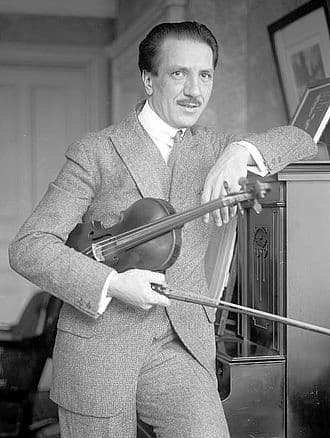Belgian violin virtuoso Eugène Ysaÿe (1858–1931) wrote his six violin sonatas, Op. 27, after hearing a performance of J.S. Bach’s six violin sonatas. One writer noted ‘these sketches, almost improvisations, emerged as six intimate portraits in music of his friends and contemporaries among violinists. Each is a masterpiece of compositional virtuosity’. Each is dedicated to a contemporary colleague/artist and follows the dedicatee’s style, resulting in six sonatas that are distinctly different from each other.

Eugène Ysaÿe
The second sonata, in A minor, is dedicated to the French violinist Jacques Thibaud (1880—1953).

Jacques Thibaud
Thibaud is most famous for the piano trio he established with Pablo Casals on cello and Alfred Cortot on piano.
The violin sonata is a unique combination of Bach and the sequence from the Requiem Mass, Dies irae. This distinctive 13th-century melody has been associated with the mass for the dead for centuries. The poem describes the ‘day of wrath’ when the trumpet sounds for the Last Judgement, when the souls of all the dead are called up before the throne of God, to be saved or to be cast into eternal damnation.
The first movement opens with a quotation from the Prelude of Bach’s Partita in E major. The light melody is interrupted by vivid descents, it tries to return and the two melodies dispute their ascendency until the Dies irae melody appears. The subtitle for this work is Obsession and the fight between Bach and the Dies irae obsesses the composer. In a way, Ysaÿe could be making an argument for the burden of Bach’s music persisting until death.
Eugène Ysaÿe: Sonata for Solo Violin in A Minor, Op. 27, No. 2 – I. Prelude, “Obsession” – Poco vivace (Tianwa Yang, violin)
The slow movement, entitled ‘Maliconia’ releases the tension of the first movement with a turn toward the minor. Eventually, the Dies irae emerges from the muted wanderings.
Eugène Ysaÿe: Sonata for Solo Violin in A Minor, Op. 27, No. 2 – II. Malinconia: Poco Lento (Tianwa Yang, violin)
The third movement saraband, subtitled Danse des ombres (Dance of the shades), starts with the Dies irae in the form of a plucked Sarabande and then is followed by a set of variations: opening with a bowed section, then a Musette, played over a sustained open string imitating the bagpipe of the title. The third variation moves to G minor, the fourth has a running accompaniment in the top part while, at the same time, the Dies irae appears below it. The fifth variation is in triplets and the last variation speeds it all up even more. The movement closes with a sweeping return of the opening, now bowed and not plucked.
Eugène Ysaÿe: Sonata for Solo Violin in A Minor, Op. 27, No. 2 – III. Sarabande (lento): “Danse des ombres” (Dance of the shades) (Tianwa Yang, violin)
The final movement, entitled Les furies, brings out all the bravura effects, including eerie work sul ponticello (playing near the bridge of the violin, bringing out a glassy sound).
Eugène Ysaÿe: Sonata for Solo Violin in A Minor, Op. 27, No. 2 – IV. Les Furies: Allegro furioso (Tianwa Yang, violin)
As a composer, Ysaÿe lacked formal training but shows in this work the art of the virtuoso. These six sonatas, each dedicated to a different virtuoso, each have a different style. No. 1 was dedicated to the Hungarian Joseph Szigeti, who did the performance of Bach’s Sonatas and Partitas which was Ysaÿe’s inspiration for this entire set. No. 3 was dedicated to the Romanian violist George Ensescu and is filled with dotted rhythms. No. 4 was for Fritz Kreisler, with a brilliant finale that brings to mind Kreisler’s own compositions. No. 5 was for Ysaÿe’s student, the Belgian violinist Mathieu Crickboom, who was a member of Ysaÿe’s own quartet before going to found his own. The last Sonata, which was composed as a single movement, was dedicated to the Spanish virtuoso Manuel Quiroga and brings in Spanish rhythms and styles, particularly in the second section and the highly virtuosic finale.
For more of the best in classical music, sign up to our E-Newsletter

